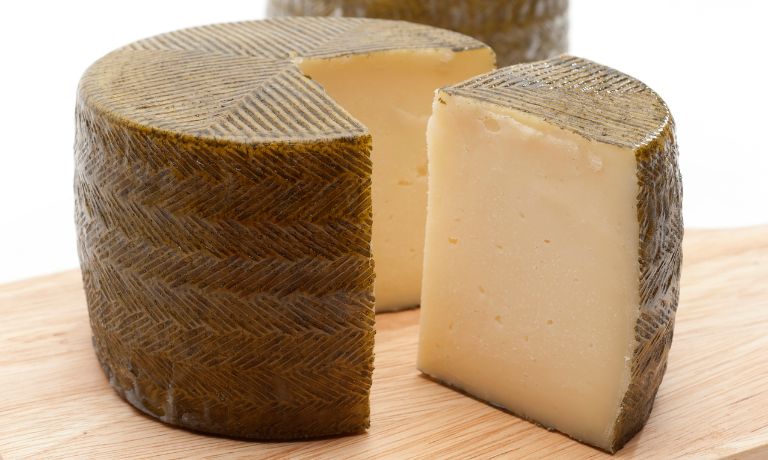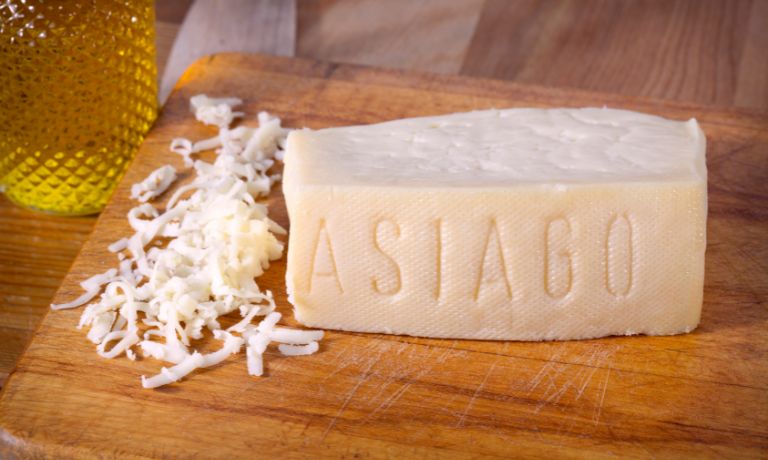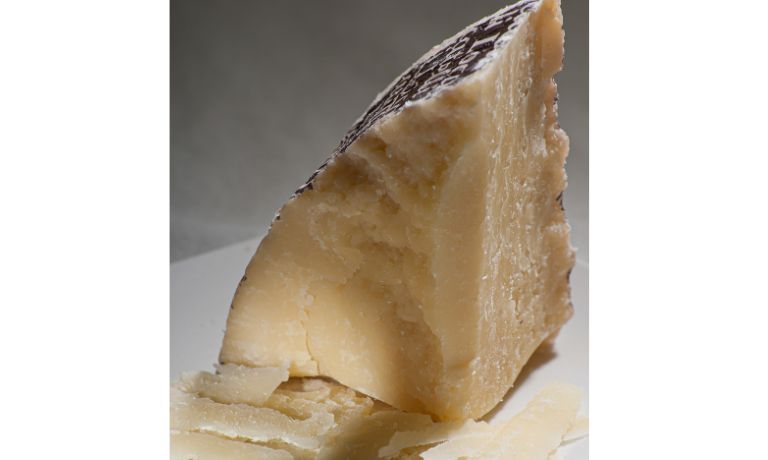If you’ve ever gone shopping for cheese, you probably know that Manchego is one of the more difficult cheeses in some parts of the world.
But there are plenty of excellent options to substitute for manchego cheese available!
In this blog post, we will introduce readers to popular alternatives for Manchego cheese and discuss why these substitutes measure up well against the original.
What Is Manchego Cheese?
Manchego cheese is a type of cheese made from the milk of Manchega sheep.
It originates in La Mancha, Spain, aged between two and twelve months.
The flavor can range from tangy to nutty, depending on the aging time.
Manchego cheese can be eaten as a snack, served with tapas or as part of a larger meal.
It can be grated onto salads, melted into sauces, or grilled and served as a sandwich filling.
This cheese pairs well with cured meats, fruits such as apples and pears, and nuts.
It is also used to make queso fundido (a traditionally Mexican baked cheese dish).
In addition, Manchego can be used for baking, such as in a tart or quiche.
Manchego is an ideal cheese on hand when looking for something special to serve guests.
Its bold flavor and texture make it a great addition to any meal.

Substitutes For Manchego Cheese
Manchego is a popular and unique Spanish cheese with a sharp, nutty flavor.
If you don’t have access to Manchego cheese or would like an alternative, several different kinds of cheese can be used instead.
Cheddar Cheese
Cheddar cheese is a hard, off-white to yellowish cheese originating in the English village of Cheddar.
It is one of the most popular cheeses in the world and is widely available in grocery stores and specialty retailers.
Cheddar cheese has a mild flavor when young but can become sharper with age, making it an ideal candidate for grating or melting.
It can also be used in many dishes Manchego would normally use, such as macaroni and cheese, grilled cheese sandwiches, quesadillas, and omelets.
Cheddar has a slightly lower fat content than Manchego, so it may also be a healthier choice for some dishes.
It is also more widely available in stores than in Manchego, making it easier to find.

Mozzarella Cheese
Mozzarella cheese is a soft Italian cheese made from cow’s milk.
It has a mild, slightly salty flavor and an easily recognizable stretchy texture when melted.
Mozzarella is often used as a topping on pizzas and in various Italian dishes such as lasagna.
The cheese can be eaten fresh or aged for several months to develop a more intense flavor.
Mozzarella and Manchego cheese have many of the same characteristics.
Both kinds of cheese are white to pale yellow in color, semi-hard, and have a mild flavor with some saltiness.
Mozzarella is often used to replace Manchego in dishes where melting or stretching is desirable, such as pizza or grilled cheese sandwiches.
Additionally, the cost of Mozzarella is often lower than Manchego, making it a more affordable option.

Asiago Cheese
Asiago cheese is a cow’s milk cheese originating from the alpine regions of Italy and parts of Austria.
This semi-hard cheese has a nutty, savory flavor ranging from mild to sharp in intensity, depending on age.
Asiago is a great substitute for Manchego because it also has a nuttiness but not as intense, and it has a much creamier texture.
It is also an excellent melting cheese, making it great for recipes such as macaroni and cheese or lasagna.
Additionally, Asiago is easier to find than Manchego in most grocery stores.
Lastly, Asiago can be much more affordable than Manchego because it is a less labor-intensive cheese.

Muenster Cheese
Muenster cheese is a light yellow cheese that originated in the Alsace region of France.
It is made from pasteurized cow’s or goat’s milk and aged for at least 10 days.
Its flavor is mild, slightly tangy, and creamy, with a sweet finish.
Muenster has an orange-hued rind, sometimes coated with red or yellow paraffin wax.
It has a similar flavor profile to Manchego and melts nicely, making it ideal for quesadillas, sandwiches, or grilled cheese.
Muenster is also relatively affordable compared to Manchego when considering the cost per pound.
The texture of Muenster is slightly looser than that of Manchego, but it still provides the same level of creaminess and flavor.

Parmesan Cheese
Parmesan cheese is a hard, aged cheese made from cow’s milk.
It is one of the world’s most popular and widely used cheeses, and it has been produced for centuries in Emilia-Romagna, Italy.
Parmesan cheese has a strong flavor and aroma, resulting from its long aging process of up to two years.
It is often used as a grating cheese and can also be served on top of pasta dishes or salads.
It has a similar flavor profile but less sharpness than Manchego cheese. Parmesan cheese is also easier to find than Manchego cheese.
Additionally, Parmesan cheese is usually less expensive than Manchego cheese, which makes it an affordable substitute.
Because of its hard texture and strong flavor, Parmesan cheese is often used as a topping or garnish, whereas Manchego cheese is often used as an appetizer or snack.
Lastly, Parmesan cheese is generally easier to melt than Manchego cheese, making it a great choice for dishes like macaroni and cheese requiring it.

Pecorino Romano
Pecorino Romano is an Italian sheep’s milk cheese made from the milk of a specific breed of sheep called the Sardinian pecorino.
Pecorino Romano has been produced in Italy for centuries and is often used as a substitute for Manchego.
Unlike Manchego cheese, Pecorino Romano is often aged up to two years, giving it a more intense flavor.
It has a distinctively sharp taste and can be used in many dishes instead of Manchego.
It also pairs well with other ingredients such as olives, fruits, cured meats, and honey.
Pecorino Romano can also be used in cooking, as a topping for salads and pasta, or even grated over dishes that call for Manchego.

Zamorano Cheese
Zamorano cheese is a Spanish cheese made in the Zamora province of Spain.
It is a hard, aged cheese traditionally made from sheep’s milk (although today cow’s milk may also be used).
The flavor of Zamorano cheese is described as sharp and slightly salty with nutty undertones.
Zamorano Cheese is a great substitute for Manchego cheese because it has a similarly sharp and slightly salty taste.
It also has a firmer texture, making it ideal for grating and slicing.
Zamorano cheese can be used in various recipes, from salads to sauces, or served as an appetizer with bread and olives.
Its strong flavor makes it especially suitable for dishes with bold flavors.
FAQs
Is Manchego Cheese The Same As Parmesan?
No, Manchego cheese is not the same as Parmesan.
While both are hard, aged cow’s milk cheeses, Manchego cheese originates from Spain and has a distinct nutty flavor.
Parmesan, on the other hand, is an Italian cheese with a sharp salty flavor.
Is Manchego Cheese Similar To Gouda?
Manchego cheese is a hard, aged cheese originating from Spain.
It is made with sheep’s milk and has a firmer texture and nutty flavor than Gouda, which is usually made with cow’s milk and has a milder taste.
Both types of cheese are great for melting and can be used in various recipes.
Is Manchego Cheese Similar To Pecorino?
Yes, Manchego cheese is similar to Pecorino in that they both are hard, sharp-tasting Italian cheeses made from sheep’s milk.
However, Manchego has a slightly nuttier flavor than Pecorino and the texture of Manchego is firmer and drier.
Conclusion
Manchego cheese is a popular Spanish cheese made from sheep’s milk.
However, if you can’t find or need a substitute for manchego cheese, several other kinds of cheese could serve as good substitutes.
Mozzarella, Asiago, Muenster, Parmesan, Pecorino Romano and Zamorano cheese are all good substitutes for Manchego.
Each cheese has its unique flavor and texture, so choose the one that suits your needs best.
Ultimately, any of these cheeses can make a delicious addition to your recipes!

